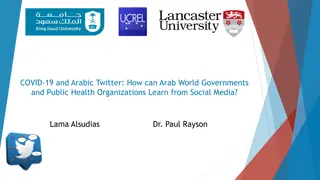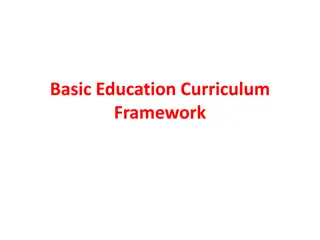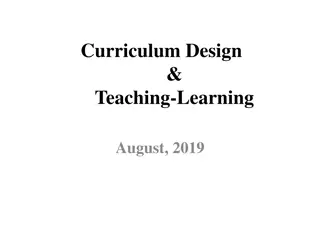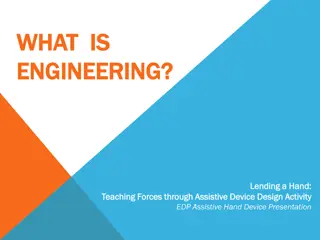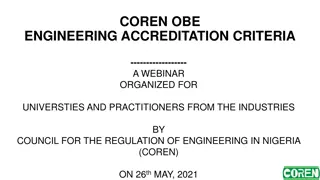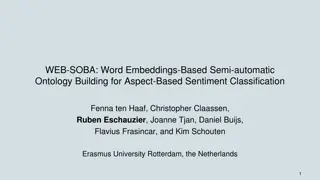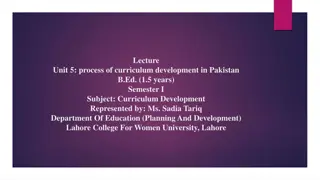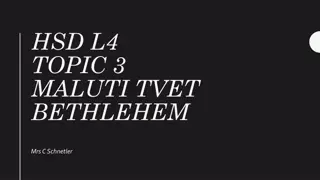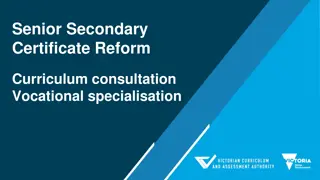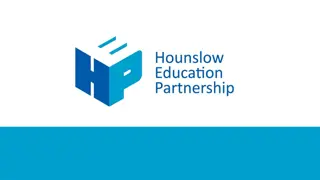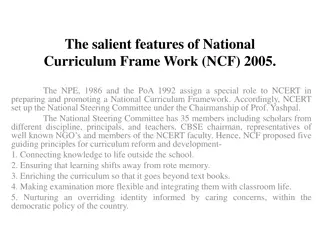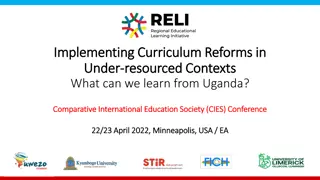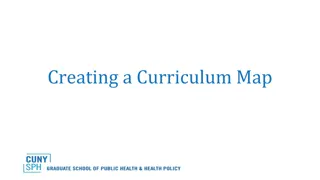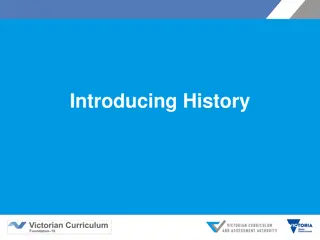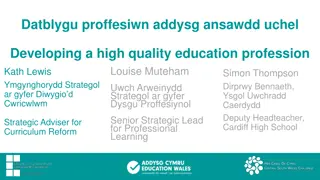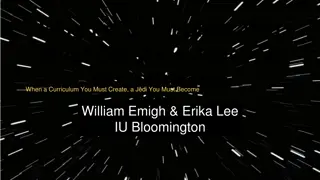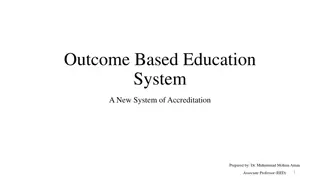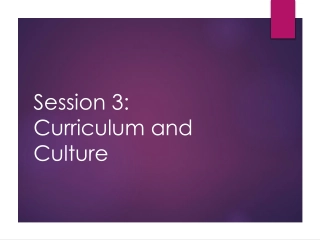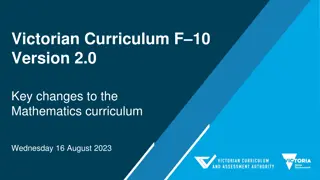Leveraging Ontologies for Modern Curriculum Design in Engineering Education
Developing a contemporary academic curriculum requires adherence to industry demands, connectivity to global programs, and incorporation of technological tools like ontologies. Discover how ontologies facilitate curriculum design and the transition from conventional to modern approaches, highlighting key tools and models for curriculum development. Learn about the origins and significance of ontologies in refining conceptual frameworks for educational curricula.
Download Presentation

Please find below an Image/Link to download the presentation.
The content on the website is provided AS IS for your information and personal use only. It may not be sold, licensed, or shared on other websites without obtaining consent from the author. Download presentation by click this link. If you encounter any issues during the download, it is possible that the publisher has removed the file from their server.
E N D
Presentation Transcript
Ontologies Ontologies - - Facilitators for Curriculum Design in Facilitators for Curriculum Design in Centers Centers of Excellence for Engineering Education of Excellence for Engineering Education Assoc. prof. Maria-Iuliana Dascalu, PhD Elisabeth LAZAROU, Melania NI U, Iulia-Cristina ST NIC , Constan a-Nicoleta BODEA, Alexandra-Maria DOBRESCU University POLITEHNICA of Bucharest, Faculty of Engineering in Foreign Languages eLSE Conference, Bucharest, April 11th-12th2019
Introduction Introduction Developing and maintaining a solid modern academic curriculum is not an easy task: Education must be correlated to the rapid changing industry needs => curriculum design is a continuous endeavour. In order to be accepted by the academic community, each curriculum must respect certain rules (credits, prerequisites and so on) => curriculum design is a complex negotiation process taking place before implementing it in a real environment. Each study programme has to be interconnected to other programmes from all over the world, due to globalization requirements => curriculum design has to reflect globalization. A lot of technological opportunities are available to support and optimize the process of curriculum design, by making it semi-automatic and less prone to errors, in the form of curriculum management systems (CMS). Ontologies play an important role in the conceptualization of educational curricula.
Conventional Approaches of Curriculum Design Conventional Approaches of Curriculum Design
Modern Approaches of Curriculum Design Modern Approaches of Curriculum Design Ontological-based tools for curriculum development and improvement: Ontology Aware Course Management for Curriculum Evolution Process in HE CURONTO, an OWL-based system to easiness curriculum assessment, review and development CUBER, an ontology-based system which facilitates the exchange of information between universities and students an autonomous solution for curriculum design by Sadi, based on agents Ontological models for curriculum design: The Bologna Ontology: http://diuf.unifr.ch/main/xi/bowlogna BBC Curricula Ontology: https://www.bbc.co.uk/ontologies/curriculum CCSO: http://xworks.gr/ontologies/ccso.owl
Ontology: Origins, History and Definitions Ontology: Origins, History and Definitions a philosophical discipline a branch of philosophy that deals with the nature and the organisation of reality science of being (Aristotle, Metaphysics, IV, 1) in Computer Science, is an engineering artefact which reduce conceptual and terminological confusion by providing a unified framework for describing the concepts of the world and their relations
Usage of Ontologies (in e Usage of Ontologies (in e- -Education) Education) Ontologies and cooperation between people and organizations improve communication Ontologies are cross-platforms, cross- applications interoperability -> improve Provide specification reusability, reliability, M. Al-Yahya, R. George, and A. Alfaries, Ontologies in e-Learning: Review of the Literature, Int. J. Softw. Eng. Its Appl., vol. 9, no. 2, pp. 67 84, 2015.
Ontologies in Curriculum Development Ontologies in Curriculum Development Foster the transparency, collaboration, exchangeability and interoperability (M. C. Van der Wende, The Bologna Declaration: Enhancing the Transparency and Competitiveness of European Higher Education, J. Stud. Int. Educ., vol. 4, no. 2, pp. 3 10, 2000) Support the aligning, classification, comparing, and matching between universities, educational systems or relevant disciplines (H. Chung and J. Kim, An Ontological Approach for Semantic Modeling of Curriculum and Syllabus in Higher Education, Int. J. Inf. Educ. Technol., vol. 6, no. 5, pp. 365 369, 2016) Help in managing the educational offerings of an institution, revealing useful information like course overlapping, uncovered or less covered areas, possible synergies between courses (M. Ronchetti and J. Sant, Curriculum Management and Review: an ontology-based solution, Trento, Italy, 2007) Supports personalization, recommendation etc in e-learning (M.I. Dascalu & all, How social and semantic technologies can sustain employability through knowledge development and positive behavioral changes, Computers in Human Behavior, vol. 70, pp. 507-517, 2017)
Usage of Ontologies in Curriculum Development Usage of Ontologies in Curriculum Development
Structure of an Ontology Structure of an Ontology Ontologies typically have two distinct components: Names for important concepts in the domain (common vocabulary) Background knowledge/constraints on the domain Example: Names for important concepts in the domain: Course, Curriculum, Level of education (or Education Stage), Types of educational activities evaluation workshop, teaching evaluation method, teaching seminar, type of educational organization, type of employee (academic staff or not), Field of Study, Discipline, Knowledge Body, Knowledge unit, Learning outcome, Topic of Study, Prerequisites Background knowledge/constraints on the domain: Each Course has to have some Learning outcome Each Course isTaught by an Academic_staff
Whats inside an OWL ontology? What s inside an OWL ontology? Classes/concepts + class-hierarchy - subclasses Individuals/objects/instances Relations between classes - inheritance, disjoint_with, equivalence Properties (slots) / values: Object properties, relations between instances of two classes: A course isTaught by an academic staff. Datatype properties, relations between instances of classes and literals/datatypes: A course hasCredits 5 Characteristics of properties: symmetric - isColleagueWith transitive- hasPart functional hasPhDAdvisor (Mary hasPhDAdvisor MrsRobinson, Mary hasPhDAdvisor Anne=>Mrs Robinson is Anne) inverse functional hasStudentNumber (Mary hasStudentNumber 87324, MsSmith hasStudentNumber 87324 => Mary is MsSmith) Restrictions on properties (type, cardinality): The teacher of a Person is also a Person => type of teacher is Person Any person must have exactly 1 PhDAdvisor= > cardinality of hasPhDAdvisor property is 1. Annotations (comments ) Reasoning tasks: classification, consistency checking
An Ontology An Ontology- -based Model for Curriculum Design in based Model for Curriculum Design in EXTEND Centres EXTEND Centres The EXTEND project consists in the building of excellence centres of engineering education in Russia and Tajikistan , which should be equipped with a toolbox of educational instruments and should provide courses for university teachers in becoming better professionals. An ontology and a related computer-based application are proposed to: support the knowledge transfer between EXTEND centres in different countries and regions exchange activities between those centres make possible the double graduation certificates and so on keep up-to-date and trackable curricula
Proposed Proposed EXTEND EXTEND Ontology Ontology a directed graph, having concepts on vertices and relationships between concepts on labeled edges
Various Types of Relationships in EXTEND Ontology Various Types of Relationships in EXTEND Ontology The concepts are structured in a hierarchy, but other relationships between them exist, e.g.: TeachingCompetencies means the right Attitude, enough domain Knowledge and Skills (of presentation, of speaking in English, of knowing how to exploit IT tools) TeachingCompetencies is equivalent to offering courses to AcademicStaff.
Why to Use Ontologies in EXTEND Why to Use Ontologies in EXTEND Centers Centers? ? The Ontology file can be easily interchanged and edited between various centres in the EXTEND network, disregarding the location or the tool used to exploit the ontology. Each centre might have its own LMS and add a simple module to exploit the common ontology => increase exchangeability and interoperability between educational environments.
Use Cases of EXTEND Ontology (1) Use Cases of EXTEND Ontology (1) adding new concepts in the ontology: EmbraceDiversity, EstablishRespectfulEnvironment, Leadership, which, description were classified automatically as attitude TechnicalSkills and PresentationSkills were classified as Skills. The automated classification is possible due to ontology related tools, e.g. Prot g - https://protege.stanford.edu/. For the particular case of EXTEND centres, each local center can blend its own competencies within the well-accepted curriculum framework. based on their competencies, while
Use Cases of EXTEND Ontology (2) Use Cases of EXTEND Ontology (2) interrogating the ontology to find out gaps, overlapping courses, existent competencies etc. (with SPARQL) What are the competences obtained after graduating an EXTEND program?
Which Courses cover a certain Area? Knowledge
Use Cases of EXTEND Ontology (3) Use Cases of EXTEND Ontology (3) merging and aligning two different curriculum ontologies, thus supporting the knowledge centres in different regions, exchange activities between those centres, certificates and so on. A Java-based tool, using the JENA engine was created to align the ontologies. Complex algorithms concepts from applied. The EXTEND centres could have own ontologies which might be merged or could establish collaboration with institutions outside their network. transfer between countries and double graduation of finding ontologies similar were both
Conclusions Conclusions The current study proposed a curriculum ontology for EXTEND centres international centres for excellence in engineering education. Three use cases of the ontology are identified and validated: adding new concepts, querying useful information and merging the ontology with other similar ontologies, in order to facilitate the knowledge transfer between educational institutions. For validating and testing the ontology, two types of tools were used: already developed ones (e.g. Prot g ) or customized ones (the Java-based API to merge ontologies). In the future, the ontology might be exploited in the centers from Russia and Tajikistan, with the help of the European partners from the EXTEND project. This work has partially received funding from the European Union s Erasmus+ Capacity Building in Higher Education program under grant agreement No. 586060-EPP-1-2017-1-RO-EPPKA2-CBHE-JP for the EXTEND project.
www.mariaiulianadascalu.com maria.dascalu@upb.ro






